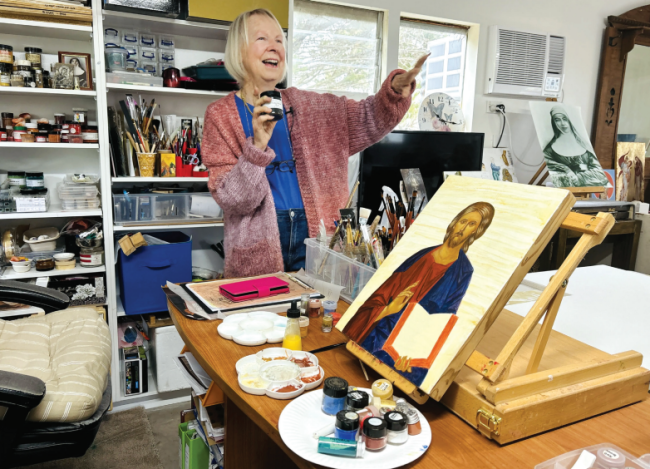The sacred art of iconography: A window to heaven in Wamboin

Iconographer Sue Orchison in her Wambion studio
Sitting in her cozy Wamboin studio, surrounded by brushes, tiny pots of color, and images of Jesus, Mary, and the saints, Sue Orchison gently dabs gold paint onto her icon.
“We contemplate the icon as a door to heaven, and the gold takes you to a place in the presence of Christ,” she says. “The gold represents eternity and heaven. It represents God, so it draws you into a beautiful place.”
Sue, who has been studying iconography for almost 20 years, has icons on display throughout the Archdiocese, from St. John the Evangelist church in Jugiong and St. Thomas the Apostle in Kambah to Mary MacKillop College in Erindale and St. Christopher’s Cathedral in Manuka.
“Iconography is how we make the unseen God seen in our lives,” she explained. “We can do that because when Veronica passed by Christ on the way to the cross, she gave him a veil. He wiped his face with the veil, and that icon is called Not Made With Human Hands. It’s Christ. He made it Himself, and this is why we can paint icons.”
As a little girl, Sue was drawn to creating pictures of Jesus.
“I would paint the traditional Renaissance images of Jesus, which were lovely, but I thought, I don’t need to do those beautiful faces of Jesus because Michelangelo’s already done them,” she said.
“And then when I grew up a bit, I started painting landscapes and portraits, but it never satisfied me because I thought well, other people do this a lot better than I do. Then I found iconography and the images of Jesus that moved my heart.”
One hundred and ten icons later, Sue still holds the same joy for her work.
 “For me, personally, to be able to paint these icons is about expressing who I am and what I love deeply, which is Christ and his mother,” she said. “It’s very precious to me that I can paint that.”
“For me, personally, to be able to paint these icons is about expressing who I am and what I love deeply, which is Christ and his mother,” she said. “It’s very precious to me that I can paint that.”
The traditional art of making an icon is an exacting process, ‘written’ in accordance with the canon—the system of symbols and approved ways of representation of Jesus Christ, his Mother, saints, and various themes.
“There’s a lot of theology to learn and a lot of technique to learn,” Sue said.
“An icon is made first using egg tempera on the wooden board—egg yolk, mixed with white wine to preserve it, then I add the raw pigments—often cinnabar for reds, ochre for yellows, and lapis-lazuli for blues. Our own personalities come through, and our own relationship with God comes through, but we follow the tradition we can see from other iconographers over the 2000 years they have painted and from what the canon says.”
An icon is not just a religious painting, but a sacramental work that invites two-way communication.
“Christ is present with us here on this earth, but icons almost make him more present in some ways,” Sue said. “I can sit in front of this image of Christ, and he’s looking at me, and I’m relating to him. All people in icons have their mouths closed because they are listening to the word of God. So also, Christ is listening to you in an icon. Christ is relating to you. I feel that I can pray well in the presence of an icon.”
Sue paints every day, does research into iconography, and takes lessons constantly.
“I follow the courses, which inspire me to then go on to paint another icon based on what I’ve learnt there,” she said. “But I realised that with iconography, you have to be working out problems constantly: Is the weather just right for everything to dry? How do I paint that fold? How do I get the right color? Will the halo be as beautiful as I want it to be without overwhelming the image of Christ? I constantly doubt myself, even though I’ve done over 100 icons. It’s wonderful to have teaching along the way.”
As Sue paints, she listens to the Rosary or stories of the saints. Each icon takes between six weeks to three months.
“So, I became familiar with the saints that I’m portraying—just extraordinary people who went before us and, with the love of Christ, healed the world,” she said.
“It’s very humbling to be painting these people. The kingdom saints are extraordinary.”


